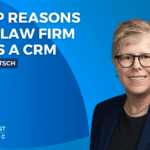Redefining CRM Success – Part 1

Getting professionals to input or manage contacts in CRM has always been a goal – and a real challenge. It’s time to reset those unrealistic expectations and redefine the concept of CRM success.
As CRM Success Consultants, one of the questions we most frequently ask our clients is “What would successful CRM look like for your firm?” Asking stakeholders to define CRM success is an effective way to uncover current pain points and also helps to understand where they are currently versus where they want to be. We see many common threads in their answers, such as “fewer manual processes, “less reliance on spreadsheets,” “greater efficiency” and “better sharing of information.”
But one of the top answers we hear most frequently is that success would be better attorney adoption of the CRM. When pressed on what they mean by adoption, most stakeholders say that they would like to see more attorneys actively contributing contacts to the system, looking up information, running reports on their own – and, ideally, adding information such as activities and notes to their contact records. (Spoiler alert: most attorneys won’t do any of these things!)
The “CRM Adoption = CRM Success” Paradigm
How did we get to the point of expecting lawyers to actually “use” CRM? In short, because it’s their information in the system – their clients and contacts and their relationships with those people and companies. A system called Client Relationship Management presupposes the existence of clients and relationships, and that information is entirely dependent upon the lawyers who have the clients and those relationships – the elusive “who-knows-whom” information that firms are always trying to capture and use.
Legal industry CRM has always been about making it easier to transfer all this contact and relationship information from lawyers’ address books (or heads) into a central system that could facilitate the sharing of the information throughout the firm. This is why marketing technology evolved from requiring lawyers to push a button to synchronize their Outlook contacts, to a no-click-required synchronization (but with lawyers still controlling which contacts get shared). But even while CRM systems could be configured to “auto-magically” pull in all contacts as a way around the human roadblock, many firms didn’t take advantage of this option and were left with diminishing returns as fewer and fewer contacts were actively shared with the central system over time.
Then there is the added wrinkle of lawyers not keeping up with their contact records. Instead of taking the time to update their Outlook address books, they often simply search their email for the last communication with a contact and hit reply or find a signature block to pull a contact’s phone number. Either way, the net result is that CRM systems that rely on the lawyers to do ANYTHING additional – regardless of how few clicks or keystrokes that may entail – are becoming more and more inaccurate and under-populated over time. The contacts and relationships – the C and R of CRM – often don’t even exist in the system that is designed to manage that exact information.
The “CRM Adoption” Reality
The truth is that the firms that define CRM Success by attorney adoption are setting themselves up for disappointment if not failure. Why? Because time is money in a law firm – literally – and learning to use CRM and entering information into it require spending non-billable time, which most lawyers are not willing to do. There are other reasons too: some more senior lawyers are not interested in learning new technology, many CRM systems are not user-friendly and can be difficult to navigate and, for the vast majority of firms, there is no mandate (or sometimes even encouragement) from firm leadership for lawyers to use the CRM system. This is one of the main reasons it’s estimated that up to 70% of CRM implementations fail to meet expectations.
Is CRM “failure” the fault of the lawyers, the technology, or just unrealistic expectations? One of the benefits of working in the legal marketing technology industry for so long is the perspective we have gained from years of experience with law firm marketing technology. After seeing hundreds of firms experience what they consider “failed” CRM implementations, it may be helpful to redefine success and acknowledge that firms may be less disappointed if they had more realistic expectations.
Read Part 2- Redefining CRM Success
For more than 10 years, the team at CLIENTSFirst Consulting has been helping professional services firms and other organizations successfully select and implement CRM and eMarketing systems and improve Data Quality to maximize value, adoption and return on investment. If you need help achieving CRM Success, please contact us at 404-249-9914 or Info@CLIENTSFirstConsulting.com.






